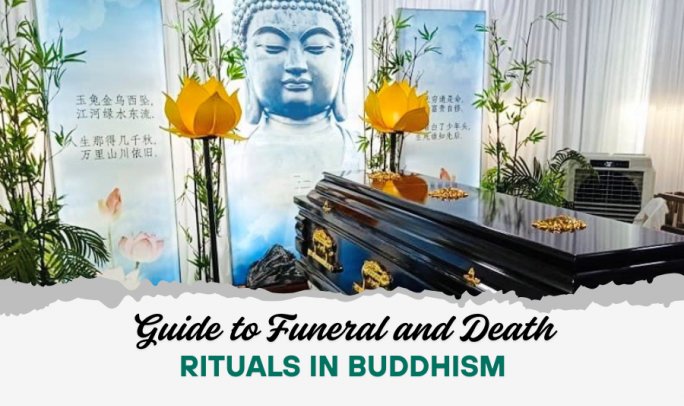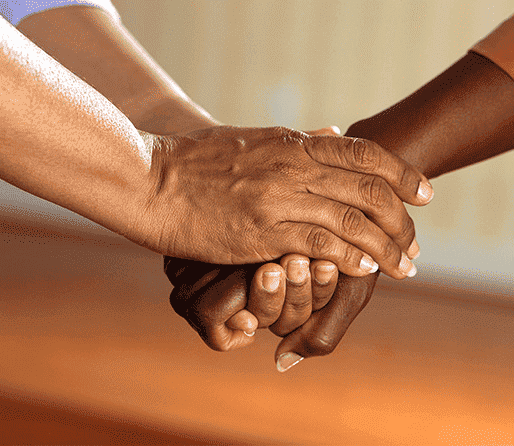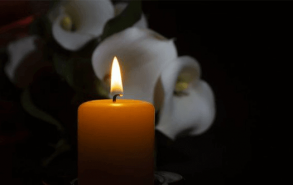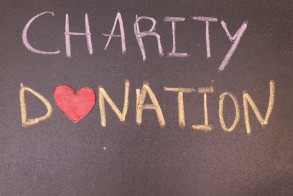Lastjourney Blog
Guide to Funeral and Death Rituals in Buddhism

 Table of Contents
Table of Contents- About Buddhism
- Buddhist Beliefs About Death
- Buddhist Death Rituals
- Buddhism and Cremation
- Variations Across Buddhist Cultures
- What to Expect at a Buddhist Funeral
- What Happens at a Buddhist Funeral Ceremony?
- What Happens After a Buddhist Funeral?
- What Happens at a Buddhist Cremation?
- How Do You Give Condolences to a Buddhist?
In Buddhist thought, death is viewed not as an end but as a transition. The process of a Buddhist funeral is deeply rooted in centuries-old traditions, rituals, and beliefs, all aimed at assisting the deceased's soul on its journey to the next life. Whether planning a Buddhist funeral, attending one, or simply curious, this guide will walk you through everything you need to know - from Buddhist death rituals to what happens after cremation.
About Buddhism
Buddhism, founded over 2,500 years ago by Siddhartha Gautama (the Buddha), is a spiritual tradition focused on personal enlightenment, ethical living, and the nature of suffering. It's practiced across many countries, including Thailand, Sri Lanka, Japan, Tibet, China, and India, with local variations in Buddhist funeral customs.
At its core, Buddhism teaches impermanence (anicca)—that all things, including life, are transient. This idea shapes how death is perceived and handled in Buddhist cultures.
Buddhist Beliefs About Death
Buddhists believe life and death are part of a continuous cycle called samsara. When a person dies, their karma (accumulated actions) influences their next rebirth. For this reason, Buddhist death rituals are designed to help guide the spirit peacefully and ensure good karma.
Key beliefs:
- Death is not an end but a rebirth.
- Calm, peaceful surroundings help the soul transition.
- Merit-making (good deeds) can benefit the deceased's rebirth.
- Monks play an essential role by chanting and leading rituals.
Buddhist Death Rituals
Preparing the Body
Immediately after death:
- The body is cleaned and dressed, often in simple white clothes.
- Family members may place a picture of the Buddha or flowers nearby.
- Chanting begins, led by monks or senior family members, to guide the soul.
Chanting and Prayers
Chanting sacred texts like the Sutra is central to Buddhist funeral traditions. The chants:
- Transfer merit to the deceased.
- Bring peace to the mourners.
- Remind everyone of impermanence.
Offerings
Food, incense, candles, and flowers are offered at home or the monastery. These offerings generate merit for the deceased.
Buddhism and Cremation
Buddhist cremation is widely practiced, though burial is also accepted in some cultures. Cremation is seen as a respectful way to return the body to nature.
- In Thailand, the cremation ceremony is often elaborate, with processions and temple rituals.
- Tibetan Buddhists may follow sky burial, where the body is offered to birds.
- Japanese Buddhists often combine cremation with family grave rituals.
At Last Journey, we assist families in arranging respectful Buddhist funeral cremation services, ensuring all cultural and religious aspects are honored.
Also Read, Understanding Insurance Coverage for Suicidal Death
Variations Across Buddhist Cultures
Buddhism is practiced in many countries, and while the core beliefs about death and rebirth remain similar, the funeral customs and death rituals can vary significantly across cultures and sects. Let's look at some important examples:
Tibetan Buddhist Funeral Traditions
In Tibetan Buddhism, death is a crucial transition point, and the rituals are deeply spiritual. One of the central practices is reading the Bardo Thodol (commonly known as the Tibetan Book of the Dead). This sacred text is read aloud to the deceased to guide the consciousness through the intermediate state (bardo) between death and rebirth.
Another distinctive Tibetan ritual is the sky burial, where the body is offered to vultures on mountaintop sites. This practice reflects the Buddhist teachings on impermanence and generosity, symbolizing the body's return to nature.
Monks or lamas often perform phowa (transference of consciousness), helping the soul move smoothly to the next life. Families may sponsor pujas (ceremonial prayers) for days or even weeks after death to accumulate merit on behalf of the deceased.
Japanese Buddhist Funeral Traditions
In Japan, Buddhist funerals are often influenced by Shinto customs and are typically highly formal. One of the most significant traditions is Obon, an annual festival held in July or August to honor ancestral spirits. During Obon, families visit graves, clean them, and offer food, incense, and lanterns to welcome the spirits home.
Japanese funerals often involve:
- A wake (tsuya) is held the night before the funeral.
- A formal funeral service (sōshiki) with chanting by priests.
- A cremation is followed by bone-picking (kotsuage), where family members use chopsticks to transfer bones into the urn.
- Periodic memorial services (hōji) are held on the 7th, 49th, and 100th days after death and anniversaries.
Japanese families often keep Butsudan (Buddhist altars) at home to pray for their ancestors.
Thai Buddhist Funeral Traditions
In Thailand, Buddhist funerals are community events marked by merit-making activities and temple ceremonies. The body is typically kept at home or in a temple for several days, during which monks visit to chant and lead rituals.
Key Thai customs include:
- Merit-making by offering food, robes, and donations to monks on behalf of the deceased.
- A funeral procession to the cremation ground is often accompanied by music and floral tributes.
- The cremation ceremony, considered a joyful send-off, helps the soul on its journey.
- Post-cremation ceremonies, where ashes may be kept in a family shrine or scattered in a meaningful place.
Thai Buddhist funerals often emphasize the communal aspect, with neighbors, friends, and monks participating actively.
The Role of Monks in Buddhist Funerals
Across all Buddhist cultures, monks play a central role in guiding the deceased and comforting the family.
Their responsibilities include:
- Spiritual Guidance: Monks help the family understand the spiritual significance of death and provide counsel on how to generate merit.
- Ritual Leadership: From chanting sacred texts to leading ceremonies, monks ensure that the proper rites are performed according to tradition.
- Blessings and Prayers: Monks offer blessings to the deceased and the grieving family, helping them navigate their sorrow and continue life's path with mindfulness.
At Last Journey, we work closely with monks and religious leaders to ensure that Buddhist funeral services respect the traditions and practices meaningful to each family.
What to Expect at a Buddhist Funeral
A Buddhist funeral ceremony can happen at home, in a funeral home, or at a temple. Expect:
- A peaceful, meditative atmosphere.
- Monks or nuns chanting sutras.
- Family and friends offering incense and bowing in respect.
- A portrait of the deceased surrounded by flowers.
What Happens at a Buddhist Funeral Ceremony?
The ceremony typically includes:
- Opening prayers and chants.
- Offering of incense and symbolic items.
- Sharing stories or eulogies.
- Transfer of merit through offerings to monks or the temple.
- Final blessing and farewell.
The tone is usually calm and reflective, focusing on the journey of the soul rather than outward grief.
What Happens After a Buddhist Funeral?
Post-funeral rituals may include:
- Cremation or burial.
- Memorial services at intervals (commonly after 7 days, 49 days, and 100 days) to help guide the soul.
- Family merit-making activities like donations or feeding monks.
Last Journey offers complete post-funeral services, including cremation arrangements and memorial prayers.
Also Read, Breaking Tradition: Last Rites in Hinduism Without a Son
What Happens at a Buddhist Cremation?
The cremation ritual involves:
- A procession to the crematorium or cremation ground.
- Final chants and blessings by monks.
- Lighting the pyre or pressing the cremation button.
- Collecting ashes and bone fragments, which are later enshrined or scattered.
What to Wear to a Buddhist Funeral
Funeral attire varies by culture, but generally:
- Wear white or light-colored clothing (avoid red, which symbolizes joy).
- Dress conservatively and modestly.
- For monks and nuns, traditional robes are worn.
Avoid flashy accessories or loud patterns; the focus should be on respect and simplicity.
How Do You Give Condolences to a Buddhist?
When offering sympathy:
- Use phrases like "I share your sorrow" or "I offer my condolences."
- A slight bow or placing palms together in prayer is a respectful gesture.
- Monetary offerings to the family or temple are standard in some cultures.
Remember, outward displays of grief are typically kept restrained in Buddhist settings.
At Last Journey, we understand the deep emotional and spiritual weight accompanying a loved one's passing. We offer:
- Complete Buddhist funeral services.
- Cremation and burial arrangements.
- Monk coordination and temple bookings.
- Customized rituals according to family traditions.
Whether you need a quiet home service or a temple-based ceremony, our team ensures every detail is handled with dignity, respect, and authenticity.
Your email address will not be published. Required fields are marked *













